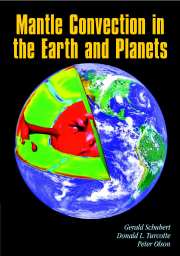Book contents
- Frontmatter
- Contents
- Preface
- 1 Historical Background
- 2 Plate Tectonics
- 3 Structure and Composition of the Mantle
- 4 Mantle Temperatures and Thermodynamic Properties
- 5 Viscosity of the Mantle
- 6 Basic Equations
- 7 Linear Stability
- 8 Approximate Solutions
- 9 Calculations of Convection in Two Dimensions
- 10 Numerical Models of Three-dimensional Convection
- 11 Hot Spots and Mantle Plumes
- 12 Chemical Geodynamics
- 13 Thermal History of the Earth
- 14 Convection in the Interiors of Solid Planets and Moons
- 15 Nature of Convection in the Mantle
- References
- Appendix: Table of Variables
- Author Index
- Subject Index
12 - Chemical Geodynamics
Published online by Cambridge University Press: 15 December 2009
- Frontmatter
- Contents
- Preface
- 1 Historical Background
- 2 Plate Tectonics
- 3 Structure and Composition of the Mantle
- 4 Mantle Temperatures and Thermodynamic Properties
- 5 Viscosity of the Mantle
- 6 Basic Equations
- 7 Linear Stability
- 8 Approximate Solutions
- 9 Calculations of Convection in Two Dimensions
- 10 Numerical Models of Three-dimensional Convection
- 11 Hot Spots and Mantle Plumes
- 12 Chemical Geodynamics
- 13 Thermal History of the Earth
- 14 Convection in the Interiors of Solid Planets and Moons
- 15 Nature of Convection in the Mantle
- References
- Appendix: Table of Variables
- Author Index
- Subject Index
Summary
Introduction
Much can be learned about the evolution of the Earth by considering the fluid dynamics of mantle convection and the associated thermal problems. However, chemical effects play a crucial role. Volcanism extracts some elements preferentially and can result in chemical buoyancy. Volcanic differentiation also preferentially extracts the radiogenic elements from the mantle into the continental crust.
In order to understand how volcanic processes influence mantle convection, it is necessary to have a general understanding of the major element petrology. However, both trace element studies and isotope studies provide important constraints. Partial melting of mantle rock concentrates incompatible elements into the resulting magma, but isotope ratios remain unaffected. Thus isotope systematics provide quantitative constraints on the long-term evolution of the mantle and processes such as the convective mixing of subducted lithosphere. In this chapter we will discuss some of these isotope families, observations of isotope ratios in rocks and in the atmosphere, and the implications for mantle convection. We will call this chemical geodynamics (Allègre, 1982, 1987). A general treatment of the use of isotopes in geology has been given by Faure (1986) and by Dickin (1995).
Geochemical Reservoirs
The primary geochemical cycle of the solid Earth is directly associated with plate tectonics and mantle convection; it is illustrated schematically in Figure 12.1. This is a box model in which the principal geochemical reservoirs are included. These are the core, the mantle, the oceanic crust, the continental crust, the oceans, and the atmosphere. In terms of the formation of the Earth, the mantle was the primary reservoir. The core was formed by the differentiation of the dense iron-rich components.
- Type
- Chapter
- Information
- Mantle Convection in the Earth and Planets , pp. 547 - 585Publisher: Cambridge University PressPrint publication year: 2001

